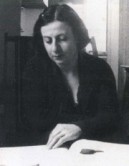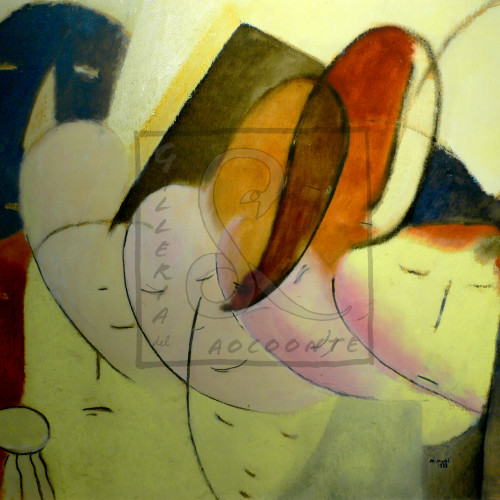 Marisa Mori (Maria Luisa Lurini) was born in Florence on 9th March, 1900. In signing her works she used the surname of her husband Mario Mori, a topographer, journalist and poet whom she married in the early twenties. In 1918 she moved with her family to Turin, where her journey into the painting world was made alone apart from some advice and encouragement by the sculptor Leonardo Bistolfi, a family friend. Later she enrolled at the private school founded and directed by Felice Casorati, at which she attended classes between 1925 and 1931 before working there. In 1926 she participated in ‘Esposizione delle vedute di Torino’ at Palazzo Bricherasio along with a group of students of the Casorati School, including Nella Marchesini, Daphne Maugham, Paola Levi Montalcini and Lalla Romano. Whilst in Turin she also took part in various exhibitions organized by the ‘Promotrice di belle arti del Valentino’ (1927, 1928, 1930). She also participated in the IV Turin Quadrenniale (1927), the Annual Exhibition of Casorati (1928); Then also in the ‘Sindacali’ of 1929, 1930, 1931 and 1932. In November 1931, in Chiavari, she participated in the exhibition of Futurist painting, sculpture and decorative arts by designing a series of ceramics that were then produced by the company Mazzotti in Albisola. In 1932, her commitment to Futurism was sanctioned by intense exhibition activity conducted together with the second generation of futurists from the regions of Liguria and Piemonte. In 1933 she was invited to the first National Futurist Exhibition in Rome, also moving to Florence with her husband, with whom she became part of the futurist group led by Antonio Marasco. Again in 1933, she won a prize at ‘I Mostra futurista di scenotecnica cinematografica’ at the Bardi Gallery in Rome for a plastic of the film ‘Sintesi dell’isola d’Elba’. Her interest in theatre and cinema led her in the mid-thirties to enrol at the acting school of the Academy of Fidenti in Florence, where, after the war, she taught history of costume. She also contributed to the drafting of ‘Cucina futurista di Marinetti e Fillia’. In April of 1934 she set up her first personal exhibition in ‘Spazio Bragaglia’ in Rome. Her futurist work was also exhibited at the Rome Quadriennale in 1931, 1935 (Ritorno dalle colonie marine) and 1939 (Concerto di fabbrica sulle Apuane). In the late thirties, in sharp disagreement with the enactment of the racial laws, she showed hospitality to Rita and Gino Levi Montalcini and put into question her relationship with futurism. Later, after her husband’s death in 1943, she finally abandoned the Marinetti movement to return to a matrix representation of classical and naturalistic themes such as portraits, still life’s, masks and nudes. In 1951 she presented a painting, ‘Studio per il ritratto di Vera Zalla’, at the VI Rome Quadriennale, after which she led a secluded life, exposing rarely and almost exclusively in women’s art exhibitions sponsored by the cultural circle Florentine Lyceum. In this last phase of her career she painted mostly human figures, landscapes or still life’s, participating also in numerous extemporaneous painting competitions. She died in Florence on 6th March, 1985.
Marisa Mori (Maria Luisa Lurini) was born in Florence on 9th March, 1900. In signing her works she used the surname of her husband Mario Mori, a topographer, journalist and poet whom she married in the early twenties. In 1918 she moved with her family to Turin, where her journey into the painting world was made alone apart from some advice and encouragement by the sculptor Leonardo Bistolfi, a family friend. Later she enrolled at the private school founded and directed by Felice Casorati, at which she attended classes between 1925 and 1931 before working there. In 1926 she participated in ‘Esposizione delle vedute di Torino’ at Palazzo Bricherasio along with a group of students of the Casorati School, including Nella Marchesini, Daphne Maugham, Paola Levi Montalcini and Lalla Romano. Whilst in Turin she also took part in various exhibitions organized by the ‘Promotrice di belle arti del Valentino’ (1927, 1928, 1930). She also participated in the IV Turin Quadrenniale (1927), the Annual Exhibition of Casorati (1928); Then also in the ‘Sindacali’ of 1929, 1930, 1931 and 1932. In November 1931, in Chiavari, she participated in the exhibition of Futurist painting, sculpture and decorative arts by designing a series of ceramics that were then produced by the company Mazzotti in Albisola. In 1932, her commitment to Futurism was sanctioned by intense exhibition activity conducted together with the second generation of futurists from the regions of Liguria and Piemonte. In 1933 she was invited to the first National Futurist Exhibition in Rome, also moving to Florence with her husband, with whom she became part of the futurist group led by Antonio Marasco. Again in 1933, she won a prize at ‘I Mostra futurista di scenotecnica cinematografica’ at the Bardi Gallery in Rome for a plastic of the film ‘Sintesi dell’isola d’Elba’. Her interest in theatre and cinema led her in the mid-thirties to enrol at the acting school of the Academy of Fidenti in Florence, where, after the war, she taught history of costume. She also contributed to the drafting of ‘Cucina futurista di Marinetti e Fillia’. In April of 1934 she set up her first personal exhibition in ‘Spazio Bragaglia’ in Rome. Her futurist work was also exhibited at the Rome Quadriennale in 1931, 1935 (Ritorno dalle colonie marine) and 1939 (Concerto di fabbrica sulle Apuane). In the late thirties, in sharp disagreement with the enactment of the racial laws, she showed hospitality to Rita and Gino Levi Montalcini and put into question her relationship with futurism. Later, after her husband’s death in 1943, she finally abandoned the Marinetti movement to return to a matrix representation of classical and naturalistic themes such as portraits, still life’s, masks and nudes. In 1951 she presented a painting, ‘Studio per il ritratto di Vera Zalla’, at the VI Rome Quadriennale, after which she led a secluded life, exposing rarely and almost exclusively in women’s art exhibitions sponsored by the cultural circle Florentine Lyceum. In this last phase of her career she painted mostly human figures, landscapes or still life’s, participating also in numerous extemporaneous painting competitions. She died in Florence on 6th March, 1985.


